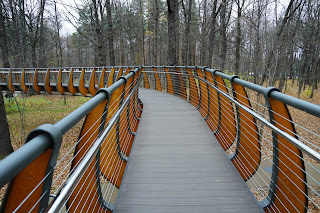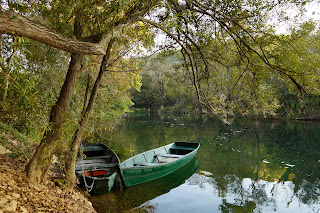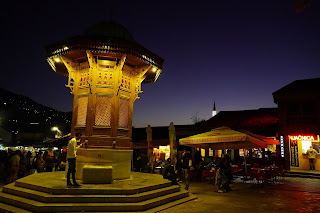One of
the things I love about working for my school is the amount of proper
vacation time I get, as it is a rarity in this industry. After some
back and forth, my long time travel buddy Bo and I decided to meet up
and travel together for a few days.
To get
the cheapest flights, I ended up flying out of Moscow at 0410. That
meant taking the last train to the airport then, hanging out for a
couple hours before checking in, then hanging out again until the
flight left. I was knackered, and I hadn't even traveled yet!
My
first flight went to Belgrade, then my second flight went to
Sarajevo. My arrival was a lot easier this time, as it was in
daytime, and I already knew how to get to my accomodation. Once I got
there I took a short nap while charging my phone, then went out.
Since
I'd arrived before Bo, I had a couple things I wanted to see and
re-take some photos that had been on the camera I'd lost in July. My
first sight on that list was the White Fortress, which sits on top of
one of the hills surrounding Sarajevo.
The hike to get up there was
just as steep as I remembered, but not quite as long since I knew
where I was going.
That
being said, I was still super sweaty by the time I got to the top.
The breeze up there as well as the views were awesome, and it felt
good to stand and look at everything.
Unlike
my last visit, the fortress was open to visitors this time around.
Entry fee was 5KM, with no maps/brochures/information provided.
I
would've liked some information, but I loved being able to wander
around the area on my own.
It looks as if some areas are being
rebuilt, I don't know if there is a plan to rebuild the whole thing
or not, I kinda hope not.
Also
unlike my last visit, my White Fortress visit took place as sunset
was starting. The views from up there were pretty fantastic, and
there were only a couple other people there. Sarajevo doesn't have a
well known skyline, especially since it sits in a valley, but sunset
over mountains is always pretty.
I
followed the twisty roads down the hill to the Yellow Fortress, which
no longer has any resemblance of a fortress. Now it's just a cafe
with another great view of the city. This one is a lot easier to get
to, and as such, was a lot busier. Heaps of people trying to get
their perfect sunset photo. I ended up taking a photo of all of them
against the sunset, which was as good as I was going to get.
Since
I had traveled a lot, I ended up heading to dinner at that point,
then went to bed and crashed early that night.
The next morning I was
up and checked out sometime in the morning, then walked my bag to the
accomodation I'd booked with Bo. I wasn't able to check in yet, but I
was able to leave my bag there, which was good enough.
I
walked through the old city centre, and found a place to buy a SIM
card for my phone. Since this trip was going to be a week long, I
figured it would be worth it to have some data access. If I
understood correctly, the way I bought my SIM card is the same as
most Bosnians, who simply top up the credit on their card from time
to time.
After
the SIM card purchase I again walked what is sometimes called
Sniper's Alley. It is a main road coming into the city, and you can
still see the marks made by bullets as they hit the buildings during
the Bosnian War in the 1990s. Nearly 30 years ago, and yet that
history is still very visible. I wonder if those bullet 'wounds' will
ever be fixed.
I
ended up missing the opening hours for the National History Museum by
just a few minutes, the same way I did during my last visit to
Sarajevo. Argh.
Obviously I should've checked those sorts of things
ahead of time, and rearranged my day accordingly. This is not the first time I've made this mistake, you'd think I would've learned my lesson by now. Whoops.
Instead
of checking out the museum, I just walked along the street for a
while, until I felt like turning around. There was nothing in
particular to see, but I wanted to walk for a while, and this seemed
like a good way to do it. After turning around, I went back to the
city center, then found a way to walk up the hill on another side of
the city, to see if I could get high enough for some kind of a city
view.
I
didn't really find a view, but I did see a few more mosques and a
couple cemeteries. There are always reminders of Bosnia's very recent
history in Sarajevo, no matter where you are in the city.
I had
dinner, then officially checked into our room, hung out for a while,
then went to the airport to meet Bo.
Bo
ended up arriving on the flight I'd taken the first time I'd come to
Sarajevo, which arrived around 2230. It was easy to meet him (as the
airport in Sarajevo is quite small,) then walk to the bus stop and
take that back into the city.
By this point I was super comfortable
with how to get to and from the airport in Sarajevo.
Bo had
been to Sarajevo before, but it was years ago, so it was a bit of a
new place to visit for him. He had no desire to repeat the war
museums, I don't blame him for that. They're intense, and somewhat
emotionally draining, so you need more time to balance them out, if
that makes sense.
I
found out he had not seen the spot where WW1 started, so our first
place to see was the plaque that marks that spot.
More visible
history. I don't know much about WW1, especially in comparison to
WW2, I probably ought to do some basic research.
After
that plaque we found a corner store to get some snacks, then walked
to the cable car station. I think he wanted to get one way tickets,
and walk our way back down the hill, but I convinced him we didn't
really have enough time in the day for that.
The
ride up the mountain was just as pretty, as some of the trees were
already starting to change colours.
Plus it was a clear day, the city
was beautiful. Once we got to the top it was easy to follow the roads
again to the top of the bobsleigh track, to explore that again.
Almost
immediately I decided I liked visiting in autumn better than summer,
simply because of the aesthetics. Some of the trees had already
dropped a few leaves, which gathered in small areas of the track,
which looked amazing in photos. Some of the graffiti had already
changed since my last visit, I suppose some of the designs end up
being painted over quite often.
We
went all the way to the bottom of the track, where we ended up
talking to two couples who were doing long term travels across
Europe, living in their own cars. They had great stories, I was
jealous. One day I want to do another long term trip, but that's
going to take a while to save for. Anywho.
We
walked back up to the top of the track, taking even more photos along
the way, as there are so many spots that scream 'take a photo' as you
walk along. I still wonder if this area will ever be monetized. Will
the government close it and start charging admission?
I led
Bo over to the other side of the station area, which gives a
completely different view of the city. Beautiful. In the grand scheme
of things these mountains are small, but even these remind you of how
small humans are in the grand scheme of things.
The
cable car took us back down the hill, then we went back to our room
to relax for a bit. We spent too long inside, because by the time we
got to the next place I wanted to see, we were 15 minutes too late.
Argh. I'd really wanted Bo to see the Svrzo house, which used to be
the house of a middle class Ottoman family back in the day of the
Empire.
Instead,
we went to the city center area, and since both of us were wearing
appropriate clothing, we visited the most famous mosque of the city.
Well, famous might not be the right word, but it is the most that
gets the most tourist visitors. After my last visit I knew how to get
inside, which was completely empty this time. There is something
about the silence in a house of faith that I absolutely adore.
After
the mosque we decided to get dinner. Bo is a chef, so food means a
lot more to him than it does to me. He usually wants to try local
food, and since I knew this, I'd asked a friend of mine to do some
research about where to find cheap local food.
We went to a place
that serves exactly one thing: cevapci.
As far
as I can tell, cevapci is a type of sausage. Of course there are
different recipes in different areas, but that's the basic
description. It is typically served in a pita, and you choose whether
you want onions, a cream cheese sauce of sorts, and how many you
want. Those were our only choices, which I kinda liked.
Not
long after eating, we made our way to the airport to pick up the hire
car I'd rented. It was only $9USD a day, inclusive of taxes and fees,
which is a pretty amazing price.
I hadn't driven stick in years, so
it took some time to remember, making it a 'fun' drive back into the
city. The other 'fun' part of this was figuring out where to park.
The
next morning, we packed up and checked out, then started our great
Bosnian road trip :)
I'd be
happy to return to Sarajevo, there is more I want to see again, and
more I want to see for the first time.






























































